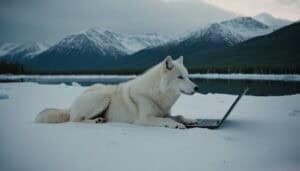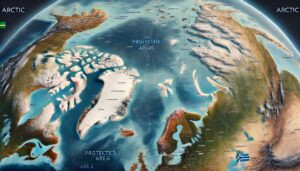Introduction
Incorporating Arctic wolf studies into the school science curriculum provides a unique opportunity to enhance student engagement and promote wildlife conservation awareness. By exploring the behavior, adaptations, and ecological roles of Arctic wolves, students can develop critical thinking skills and a deeper understanding of environmental science
This article outlines the educational benefits, integration strategies, necessary resources, key topics, and innovative approaches to effectively teach about Arctic wolves
Educational Benefits of Studying Arctic Wolves
Incorporating Arctic wolf studies into the science curriculum offers numerous educational benefits. By examining these majestic creatures, students can engage more deeply with the subject matter, cultivate a passion for wildlife conservation, and enhance their critical thinking skills
Below, we explore the key benefits of integrating Arctic wolf studies into educational programs
Enhancing Student Engagement
Studying Arctic wolves can significantly enhance student engagement by providing a fascinating and relatable subject
Arctic wolves are visually striking and have intriguing behaviors, making them an appealing topic for students. When students are interested in the subject matter, they are more likely to participate actively in class discussions, complete assignments with enthusiasm, and retain the information they learn:
Visual Appeal: Arctic wolves, with their white fur and piercing eyes, are captivating animals that can spark students’ interest and curiosity. Visual elements like photos, videos, and documentaries can make lessons more engaging
Behavioral Studies: Observing the social structure and hunting strategies of Arctic wolves provides students with exciting and dynamic content. For example, Arctic wolves hunt in packs, exhibiting complex social behaviors that can be discussed and analyzed in the classroom
Relatable Content: Many students have a natural affinity for animals. By learning about Arctic wolves, they can connect their studies to broader themes of animal behavior, biology, and ecology, making the content more relevant to their interests
Promoting Wildlife Conservation Awareness
Teaching about Arctic wolves helps promote wildlife conservation awareness among students. Understanding the challenges these animals face due to climate change, habitat loss, and human activities can inspire students to become advocates for environmental protection:
Climate Change Impact: Arctic wolves live in regions that are significantly affected by climate change. Educating students about how melting ice and changing temperatures impact Arctic wolf populations can raise awareness about the broader implications of global warming
Conservation Efforts: Students can learn about various conservation initiatives aimed at protecting Arctic wolves and their habitats. Discussing successful conservation stories can inspire students to support or participate in similar efforts
Human-Wildlife Interaction: Highlighting the impact of human activities, such as industrial development and pollution, on Arctic wolf populations helps students understand the importance of responsible environmental stewardship
Developing Critical Thinking Skills
Studying Arctic wolves encourages the development of critical thinking skills as students analyze complex ecological systems and the interactions within them. This educational approach fosters a deeper understanding of scientific concepts and problem-solving abilities:
Scientific Inquiry: Investigating the life and environment of Arctic wolves requires students to ask questions, gather data, and draw conclusions based on evidence. This process enhances their scientific inquiry skills
Problem-Solving: Students can explore real-world problems, such as habitat destruction or food scarcity, and brainstorm potential solutions. For instance, they might investigate how the reduction of prey species affects Arctic wolf populations and propose conservation strategies
Interdisciplinary Learning: The study of Arctic wolves can be integrated with subjects like geography, climate science, and social studies, encouraging students to draw connections between different fields of knowledge. This interdisciplinary approach enhances their ability to think critically and synthesize information
Incorporating Arctic wolf studies into the science curriculum can significantly benefit students by enhancing engagement, promoting conservation awareness, and developing critical thinking skills. By providing a captivating and relevant subject, educators can inspire students to explore the natural world and contribute to its preservation
Integrating Arctic Wolf Studies Into Existing Curricula
Integrating Arctic wolf studies into existing science curricula requires thoughtful alignment with educational standards, creative cross-disciplinary opportunities, and innovative project-based learning approaches
Here, we explore practical methods for incorporating this fascinating subject into classroom instruction
Aligning with Science Standards
To successfully integrate Arctic wolf studies, it is essential to align the content with established science standards. This ensures that the material complements the required curriculum and supports students’ overall educational development:
Next Generation Science Standards (NGSS): Arctic wolf studies can be aligned with NGSS by focusing on ecosystems, biodiversity, and adaptation. For example, the standards for middle school life science include learning about “Ecosystems: Interactions, Energy, and Dynamics” (MS-LS2-1), which can be directly linked to studying Arctic wolves and their roles in their habitat
Common Core State Standards (CCSS): Teachers can integrate Arctic wolf studies with CCSS for English Language Arts by incorporating reading, writing, and research projects. Students might read scientific articles about Arctic wolves, write reports, and present their findings, thus meeting literacy standards
State and Local Standards: Teachers should review their specific state and local science standards to identify where Arctic wolf studies can fit. Many standards include components related to animal behavior, environmental science, and conservation, which provide natural entry points for this topic
Cross-Disciplinary Opportunities
Arctic wolf studies can be effectively integrated across multiple subjects, offering students a richer and more comprehensive learning experience:
Geography: By studying the Arctic region, students can learn about the physical geography, climate, and ecosystems that Arctic wolves inhabit. This can include map reading, understanding biomes, and discussing the impact of climate change on the Arctic environment
Social Studies: Arctic wolf studies can tie into discussions about indigenous cultures in the Arctic, human impact on wildlife, and the importance of conservation efforts. Students can explore how Arctic wolves are perceived and treated by different cultures, particularly the indigenous peoples who share their habitat
Art and Literature: Students can express their learning through creative projects, such as drawing or painting Arctic wolves, writing stories or poems, and creating documentaries or presentations. This cross-disciplinary approach helps to engage different learning styles and foster creativity
Project-Based Learning Approaches
Project-based learning (PBL) offers an effective way to engage students with Arctic wolf studies through hands-on, inquiry-based activities that promote deep understanding and retention:
Research Projects: Students can undertake research projects on various aspects of Arctic wolf biology, behavior, and conservation. These projects can include field studies, literature reviews, and presentations. For example, students might investigate the impact of climate change on Arctic wolf populations and present their findings to the class
Simulations and Role-Playing: Teachers can create simulations or role-playing scenarios where students take on the roles of scientists, conservationists, or policy makers. This can help students understand the complexities of wildlife management and the importance of interdisciplinary collaboration
Community Engagement Projects: Students can participate in local conservation efforts, such as creating awareness campaigns or fundraising for wildlife organizations. These projects help students apply their knowledge to real-world situations and develop a sense of responsibility towards environmental stewardship
Integrating Arctic wolf studies into existing curricula enriches students’ educational experiences by providing engaging, interdisciplinary, and project-based learning opportunities. By aligning with science standards, exploring cross-disciplinary connections, and implementing PBL approaches, educators can effectively teach about Arctic wolves and inspire a new generation of wildlife enthusiasts and conservationists
Resources Needed for Teaching About Arctic Wolves
To effectively incorporate Arctic wolf studies into the science curriculum, educators need access to a variety of resources
These resources include books and multimedia materials, scientific research, and collaboration with wildlife experts. By utilizing these tools, teachers can create a rich, engaging learning environment that enhances students’ understanding of Arctic wolves and their ecosystems
Books and Multimedia Resources
High-quality books and multimedia resources are essential for providing comprehensive information about Arctic wolves. These resources can include textbooks, documentaries, websites, and interactive tools that cater to different learning styles:
Textbooks and Reference Books: Books specifically focused on Arctic wolves, such as “The Arctic Wolf: Living with the Pack” by L. David Mech, offer detailed insights into their behavior, habitat, and conservation. Additionally, general wildlife and biology textbooks can provide foundational knowledge
Documentaries and Videos: Visual media, such as documentaries like “Wolves in the Arctic” from National Geographic, can bring the Arctic environment and its inhabitants to life. These resources allow students to observe Arctic wolves in their natural habitat and understand their behaviors and interactions
Interactive Websites and Apps: Websites like the World Wildlife Fund (WWF) and apps such as iNaturalist offer interactive features, including maps, species databases, and citizen science projects. These tools can engage students in exploring and learning about Arctic wolves through interactive activities
Access to Scientific Research
Access to current and accurate scientific research is crucial for providing students with up-to-date information about Arctic wolves. Educators can use research articles, journals, and online databases to support their teaching and enhance students’ learning experiences:
Scientific Journals: Journals such as “Arctic,” “The Journal of Wildlife Management,” and “Canadian Journal of Zoology” publish peer-reviewed research on Arctic wolves and related topics. Teachers can use these articles to present the latest findings and discuss ongoing research with their students
Online Databases: Resources like Google Scholar and PubMed provide access to a vast array of scientific papers and studies. Teachers can guide students in using these databases to conduct their own research projects and explore specific areas of interest related to Arctic wolves
Institutional Collaborations: Collaborating with universities and research institutions can provide teachers with access to expert knowledge and cutting-edge research. Guest lectures, webinars, and collaborative projects with researchers can enrich students’ understanding and expose them to real-world scientific work
Collaboration with Wildlife Experts
Partnering with wildlife experts and organizations can greatly enhance the educational experience by providing firsthand knowledge and practical insights into Arctic wolf conservation and research:
Guest Speakers and Field Experts: Inviting wildlife biologists, conservationists, and researchers to speak to students can offer unique perspectives and firsthand accounts of studying and protecting Arctic wolves. These experts can share their experiences, answer questions, and inspire students
Zoo and Wildlife Sanctuary Partnerships: Forming partnerships with local zoos and wildlife sanctuaries can provide opportunities for field trips, educational programs, and direct observation of Arctic wolves. Many zoos offer educational resources and programs specifically designed for schools
Virtual Interactions: When in-person visits are not possible, virtual interactions such as video calls, webinars, and virtual tours can connect students with experts and provide immersive learning experiences. Organizations like Explore.org offer live cams and virtual tours of wildlife habitats, including those of Arctic wolves
By leveraging a diverse range of resources, including books, multimedia materials, scientific research, and expert collaborations, educators can create a dynamic and comprehensive curriculum that effectively teaches students about Arctic wolves
These resources not only provide valuable information but also inspire curiosity and foster a deeper appreciation for wildlife and conservation efforts
Key Topics When Teaching About Arctic Wolves
Teaching about Arctic wolves covers a range of key topics that provide students with a comprehensive understanding of these animals and their role in the ecosystem
By exploring the behavior, habitat, and conservation efforts related to Arctic wolves, students can gain valuable insights into the challenges these animals face and the importance of protecting them
Arctic Wolf Behavior and Social Structure
Understanding the behavior and social structure of Arctic wolves is fundamental to comprehending their survival strategies and ecological impact:
Pack Dynamics: Arctic wolves live in packs, which are essential for hunting and protection. Packs typically consist of a dominant breeding pair and their offspring. Students can study the roles within the pack, such as the alpha pair, subordinate members, and pups, to understand social hierarchy and cooperation
Communication: Arctic wolves use various methods to communicate, including vocalizations, body language, and scent marking. Teaching about howls, growls, and other vocal signals can help students learn about animal communication and social interaction
Hunting Strategies: Arctic wolves are skilled hunters, often preying on large animals like caribou and musk oxen. Discussing their hunting tactics, including group coordination and strategic planning, can provide insights into predator-prey relationships and survival skills
Habitat and Environmental Challenges
Arctic wolves inhabit some of the most extreme and remote environments on Earth. Exploring their habitat and the environmental challenges they face can enhance students’ understanding of adaptation and resilience:
Arctic Environment: The Arctic is characterized by harsh conditions, including freezing temperatures, snow, and ice. Students can learn about the specific regions Arctic wolves inhabit, such as the tundra and Arctic archipelagos, and how these environments shape their behavior and lifestyle
Seasonal Adaptations: Arctic wolves exhibit various adaptations to survive in their cold environment. For example, they have thick fur, a layer of fat for insulation, and the ability to endure long periods without food. Teaching about these adaptations helps students understand the concept of natural selection and evolutionary biology
Climate Change Impact: The Arctic is undergoing rapid changes due to global warming, which affects Arctic wolf populations. Students can study the effects of melting ice, changing prey availability, and habitat loss on Arctic wolves, highlighting the broader implications of climate change
Conservation Efforts and Challenges
Conservation efforts are crucial for protecting Arctic wolves and their habitats. Educating students about these efforts and the challenges involved fosters a sense of responsibility and environmental stewardship:
Threats to Survival: Arctic wolves face several threats, including habitat destruction, climate change, and human activities such as hunting and industrial development. Discussing these threats helps students understand the complex interplay between human actions and wildlife conservation
Conservation Initiatives: Various organizations and governments are working to protect Arctic wolves through conservation programs, protected areas, and research initiatives. Students can learn about specific efforts, such as the work of the World Wildlife Fund (WWF) and the creation of Arctic wildlife reserves
Role of Research: Ongoing research plays a vital role in understanding and protecting Arctic wolves. Students can explore how scientists study Arctic wolf populations, track their movements, and monitor their health. This research informs conservation strategies and policy decisions
Teaching key topics about Arctic wolves provides students with a well-rounded education on these animals and their ecological significance
By studying their behavior, habitat, and conservation efforts, students gain a deeper appreciation for Arctic wolves and the importance of preserving their environment. This knowledge can inspire future generations to contribute to wildlife conservation and environmental protection
Enhancing Learning Through Field Trips
Field trips offer students hands-on, immersive experiences that enhance their understanding of Arctic wolves and their ecosystems. Whether through physical visits to wildlife reserves or virtual tours, these excursions provide valuable educational opportunities beyond the classroom
Visiting Wildlife Reserves
Visiting wildlife reserves allows students to observe Arctic wolves and other wildlife in natural or simulated environments. These trips can provide a deeper understanding of the animals’ behaviors, habitats, and conservation needs:
Observing Behavior: Seeing Arctic wolves in a wildlife reserve gives students the chance to observe their behaviors firsthand. They can watch how wolves interact within their packs, hunt, and communicate, offering insights that are difficult to obtain through textbooks alone
Guided Tours: Many wildlife reserves offer guided tours led by knowledgeable staff who can provide detailed information about Arctic wolves and their habitats. These guides can answer questions, share interesting facts, and explain the importance of conservation efforts
Educational Programs: Reserves often have educational programs tailored for school groups. These programs might include interactive exhibits, hands-on activities, and presentations about Arctic wolves and the broader ecosystem
Virtual Field Trips
When physical field trips are not feasible, virtual field trips can provide an effective alternative. Technology enables students to explore distant places and learn about Arctic wolves through interactive, online experiences:
Live Streams and Webcams: Many wildlife reserves and conservation organizations offer live streams and webcams that allow students to observe Arctic wolves in real-time. For example, websites like Explore.org have live cams that broadcast wildlife activity, providing an up-close view of Arctic wolves
Interactive Tours: Virtual tours can take students through Arctic habitats, showcasing the environment and its inhabitants. Platforms like Google Earth and National Geographic offer virtual tours that include informational content, videos, and images
Expert Webinars: Virtual field trips can also include webinars with experts who discuss Arctic wolves and answer student questions. These sessions can be highly interactive, allowing students to engage directly with scientists and conservationists
Hands-On Activities and Observations
Incorporating hands-on activities and observations into field trips, whether virtual or physical, helps students apply what they’ve learned and develop practical skills:
Tracking and Monitoring: Students can learn about wildlife tracking and monitoring techniques used by scientists. Activities might include analyzing tracks, scat, and other signs of Arctic wolves, teaching students how researchers gather data in the field
Data Collection: Field trips can involve data collection exercises where students record observations, such as wolf behaviors, pack sizes, and habitat conditions. This practice enhances their understanding of scientific methods and data analysis
Art and Writing Projects: Encouraging students to create art or write about their field trip experiences can reinforce their learning. Drawing sketches of Arctic wolves, writing journal entries, or composing reports about their observations helps solidify the knowledge gained during the trip
Field trips, both physical and virtual, provide enriching educational experiences that deepen students’ understanding of Arctic wolves and their ecosystems
By observing behaviors, participating in interactive tours, and engaging in hands-on activities, students can connect more personally with the subject matter and develop a greater appreciation for wildlife conservation
Utilizing Technology in Arctic Wolf Education
Technology offers innovative tools for teaching about Arctic wolves, making learning more interactive and engaging. From interactive learning tools to virtual reality experiences and online research projects, technology can enhance the educational experience and provide students with a deeper understanding of Arctic wolves
Interactive Learning Tools
Interactive learning tools such as educational software, apps, and online platforms can make studying Arctic wolves more engaging and accessible for students:
Educational Software: Programs like BrainPOP and Kahoot! offer interactive lessons and quizzes about wildlife and ecosystems, including Arctic wolves. These tools can reinforce learning through games and activities that test students’ knowledge
Apps: Mobile apps like WWF Together and Seek by iNaturalist provide interactive experiences that allow students to explore information about Arctic wolves, participate in citizen science projects, and identify wildlife in their own communities
Online Platforms: Websites such as National Geographic Kids and Discovery Education offer a wealth of resources, including articles, videos, and interactive activities focused on Arctic wolves and their habitats
Virtual Reality Experiences
Virtual reality (VR) experiences can immerse students in the Arctic environment, providing a unique perspective on the lives of Arctic wolves and their ecosystems:
VR Simulations: VR platforms like Google Expeditions and Discovery VR offer simulations that transport students to the Arctic, allowing them to explore the habitat of Arctic wolves up close. These experiences can make abstract concepts more tangible and engaging
Interactive Experiences: Some VR experiences include interactive elements where students can engage with the environment, such as tracking a pack of Arctic wolves or exploring their dens. These interactions can enhance understanding and retention of the material
360-Degree Videos: 360-degree videos available on platforms like YouTube provide an immersive viewing experience, allowing students to look around and explore Arctic landscapes and wildlife from all angles
Online Research Projects
Online research projects enable students to delve deeper into Arctic wolf studies, fostering critical thinking and research skills:
Digital Libraries: Access to digital libraries and databases such as JSTOR and Google Scholar allows students to find and read scientific articles, studies, and reports about Arctic wolves. This research can form the basis of detailed projects and presentations
Collaborative Platforms: Tools like Google Classroom and Padlet enable students to collaborate on research projects, share resources, and present their findings. This collaborative approach can enhance learning through peer interaction and feedback
Virtual Labs: Virtual lab platforms such as Labster offer interactive simulations where students can conduct experiments and analyze data related to Arctic wolf biology and ecology. These virtual labs can provide practical experience in a controlled, digital environment
Utilizing technology in Arctic wolf education provides dynamic and interactive ways to engage students and deepen their understanding of these animals
Through interactive learning tools, VR experiences, and online research projects, technology can transform the way students learn about Arctic wolves and inspire a lasting interest in wildlife conservation
Forming Partnerships for Arctic Wolf Education
Forming partnerships with various organizations and communities can significantly enhance the educational experience when teaching about Arctic wolves
Collaborations with zoos, wildlife organizations, local communities, and securing grants and funding opportunities can provide valuable resources and support for Arctic wolf education
Collaborations with Zoos and Wildlife Organizations
Partnerships with zoos and wildlife organizations can provide students with access to expert knowledge, resources, and firsthand experiences with Arctic wolves:
Zoo Education Programs: Many zoos offer educational programs that focus on Arctic wolves and other wildlife. These programs might include workshops, guided tours, and interactive exhibits that provide students with detailed information and hands-on experiences
Wildlife Conservation Organizations: Organizations like the World Wildlife Fund (WWF) and Defenders of Wildlife have resources and programs dedicated to Arctic wolf conservation. Partnering with these organizations can provide schools with access to expert speakers, educational materials, and participation in conservation initiatives
Field Experts and Researchers: Collaborating with wildlife biologists and researchers who specialize in Arctic wolves can enrich the curriculum. These experts can provide guest lectures, conduct Q&A sessions, and offer insights from their fieldwork and research
Involving Local Communities
Engaging local communities in Arctic wolf education can foster a sense of connection and responsibility towards wildlife conservation:
Community Workshops: Schools can organize workshops and events that involve local communities in learning about Arctic wolves and conservation efforts. These events can raise awareness and encourage community participation in protecting wildlife
Citizen Science Projects: Involving students and community members in citizen science projects, such as tracking wildlife sightings or monitoring local ecosystems, can provide practical experience and contribute to real-world conservation efforts
Local Conservation Groups: Partnering with local conservation groups can provide additional resources and support for Arctic wolf education. These groups often have educational programs, volunteer opportunities, and community outreach initiatives that can complement classroom learning
Seeking Grants and Funding Opportunities
Securing grants and funding is essential for supporting Arctic wolf education programs and ensuring access to necessary resources and experiences:
Educational Grants: Many organizations and foundations offer grants specifically for environmental education and wildlife conservation. Applying for these grants can provide funding for field trips, educational materials, and guest speakers
Corporate Sponsorships: Partnering with businesses and corporations that have a commitment to environmental sustainability can provide financial support and resources for Arctic wolf education programs. Companies might sponsor field trips, provide educational materials, or fund special projects
Fundraising Initiatives: Schools can organize fundraising events, such as bake sales, charity runs, or online campaigns, to raise money for Arctic wolf education. These initiatives can involve the entire school community and foster a collective effort towards wildlife conservation
Forming partnerships with zoos, wildlife organizations, local communities, and securing grants and funding can greatly enhance Arctic wolf education
These collaborations provide valuable resources, support, and real-world experiences that enrich students’ learning and promote a deeper understanding and appreciation for Arctic wolves and their conservation
Understanding Arctic Wolf Adaptations
Understanding the adaptations of Arctic wolves provides insights into how these animals survive and thrive in one of the harshest environments on Earth
By studying their physical, behavioral, and evolutionary adaptations, students can gain a deeper appreciation for the resilience and ingenuity of Arctic wolves
Physical Adaptations to Cold Environments
Arctic wolves possess several physical adaptations that enable them to withstand the extreme cold and challenging conditions of the Arctic region:
Thick Fur and Undercoat: Arctic wolves have a dense, multi-layered coat that provides insulation against freezing temperatures. Their fur consists of a soft undercoat and a coarse outer layer, which helps retain body heat. The fur also changes color with the seasons, offering camouflage against the snow in winter and the tundra in summer
Paws and Claws: The paws of Arctic wolves are wide and covered with fur, which helps distribute their weight more evenly when walking on snow. This adaptation, similar to snowshoes, prevents them from sinking into the snow. Additionally, their claws are sharp and strong, aiding in traction and hunting
Body Size and Shape: Arctic wolves tend to be smaller than their gray wolf counterparts, with shorter ears and muzzles, reducing the surface area exposed to the cold. Their compact body shape minimizes heat loss and helps them conserve energy
Behavioral Adaptations for Survival
Behavioral adaptations play a crucial role in the survival of Arctic wolves, influencing their hunting strategies, social structure, and seasonal behaviors:
Pack Hunting: Arctic wolves hunt in packs, which allows them to take down larger prey such as caribou and musk oxen. This cooperative hunting strategy increases their chances of success and ensures that all members of the pack have access to food
Seasonal Migration: During the harshest winter months, Arctic wolves may migrate to follow the movements of their prey. This seasonal migration ensures a steady food supply and reduces competition with other predators
Denning and Pup Rearing: Arctic wolves dig dens in the ground or use natural shelters to protect their pups from the cold and predators. The pack collectively cares for the young, ensuring their survival during the vulnerable early stages of life
Evolutionary Traits
The evolutionary traits of Arctic wolves have developed over thousands of years, allowing them to adapt to the specific challenges of their environment:
Genetic Adaptations: Arctic wolves have evolved genetic adaptations that enable them to thrive in cold climates. These include genes related to fat metabolism, which help them store and utilize energy efficiently during periods of food scarcity
Reproductive Strategies: The reproductive strategies of Arctic wolves are timed to ensure that pups are born during the warmer months when food is more abundant. This seasonal breeding cycle increases the likelihood of pup survival and contributes to the stability of the population
Dietary Flexibility: While Arctic wolves primarily hunt large mammals, they exhibit dietary flexibility by scavenging and consuming smaller animals, birds, and even vegetation when necessary. This adaptability in their diet helps them survive in an environment where food sources can be unpredictable
Understanding the physical, behavioral, and evolutionary adaptations of Arctic wolves provides students with a comprehensive view of how these animals survive in their challenging environment
These adaptations highlight the remarkable resilience and resourcefulness of Arctic wolves, underscoring the importance of studying and conserving this unique species
Role of Arctic Wolves in the Ecosystem
Arctic wolves play a crucial role in their ecosystem, influencing prey populations, maintaining ecological balance, and interacting with other species. Understanding their ecological impact provides insights into the importance of preserving these apex predators and their habitats
Predatory Impact on Prey Populations
As apex predators, Arctic wolves have a significant impact on the populations of their prey, which in turn affects the entire ecosystem:
Regulating Prey Numbers: By preying on herbivores like caribou and musk oxen, Arctic wolves help regulate the populations of these species. This predatory pressure prevents overgrazing and ensures that vegetation is not depleted, which benefits the overall health of the ecosystem
Selective Pressure: Arctic wolves tend to hunt the weak, sick, or old individuals in prey populations. This selective predation promotes the health and genetic strength of the prey species, as the fittest individuals are more likely to survive and reproduce
Carcass Provision: The remains of wolf kills provide food for scavengers such as foxes, ravens, and even bears. This contribution to the food web supports biodiversity and helps sustain other wildlife species in the Arctic ecosystem
Maintaining Ecological Balance
Arctic wolves play a vital role in maintaining the ecological balance of their environment through their interactions with prey and other species:
Trophic Cascades: The presence of Arctic wolves can trigger trophic cascades, where changes in predator populations affect multiple levels of the food chain. For example, a decrease in wolf populations can lead to an increase in herbivore numbers, which in turn can result in overgrazing and habitat degradation
Biodiversity Support: By controlling prey populations and promoting vegetation health, Arctic wolves support a diverse array of plant and animal species. This biodiversity is essential for ecosystem resilience and stability
Habitat Modification: The hunting activities of Arctic wolves can influence the distribution and behavior of prey species, which in turn affects vegetation patterns and habitat structure. These indirect effects contribute to the dynamic nature of the Arctic ecosystem
Interactions with Other Species
Arctic wolves interact with various other species in their ecosystem, including both predators and prey, as well as scavengers and competitors:
Interspecific Competition: Arctic wolves may compete with other predators, such as polar bears and foxes, for food resources. This competition can influence the distribution and behavior of all involved species, shaping the ecological dynamics of the region
Symbiotic Relationships: Arctic wolves can have symbiotic relationships with other species. For instance, their hunting activities can benefit scavengers that rely on wolf kills for food. Additionally, wolves may indirectly support plant species by controlling herbivore populations and preventing overgrazing
Human-Wildlife Interactions: The presence of Arctic wolves can also impact human activities, such as hunting and livestock rearing. Understanding these interactions is crucial for developing effective conservation strategies that balance wildlife protection with human needs
By examining the predatory impact, ecological balance, and interactions of Arctic wolves, students can appreciate the complex and vital role these animals play in their ecosystem
This knowledge underscores the importance of conserving Arctic wolves and their habitats to ensure the health and stability of the Arctic environment
Conclusion
Incorporating Arctic wolf studies into the school science curriculum offers a multifaceted educational experience that enhances student engagement, promotes conservation awareness, and develops critical thinking skills
By understanding the behavior, adaptations, and ecological roles of Arctic wolves, students gain a deeper appreciation for wildlife and the challenges these animals face in their harsh environments
Through careful integration into existing curricula, using resources such as books, multimedia, scientific research, and expert collaborations, educators can create dynamic and comprehensive learning experiences. Field trips, both physical and virtual, further enrich the curriculum by providing immersive, hands-on learning opportunities
The use of technology, including interactive learning tools and virtual reality, offers innovative ways to teach about Arctic wolves, making the subject more accessible and engaging for students. Additionally, forming partnerships with zoos, wildlife organizations, and local communities, as well as seeking grants and funding, provides valuable support and resources
Understanding the physical, behavioral, and evolutionary adaptations of Arctic wolves, as well as their crucial role in maintaining ecological balance, underscores the importance of studying and conserving this remarkable species. By incorporating Arctic wolf studies into the science curriculum, educators can inspire a new generation of wildlife enthusiasts and conservationists, fostering a commitment to protecting our planet’s biodiversity










